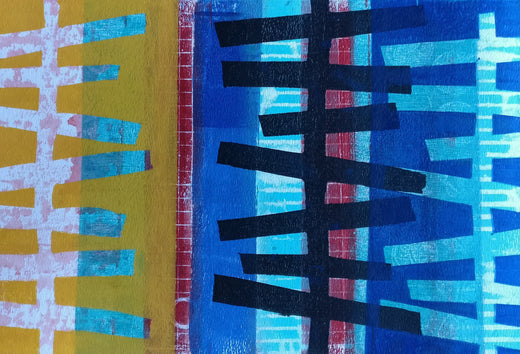
Making Your Own Stencils and Masks for Gel Printing
Many companies and artists sell fantastic stencils for gel printing and mixed media art, but I am a big believer in the D.I.Y. approach to stencils and masks.
I have purchased a few stencils over the years and they certainly hold up well, but eventually they end up in my bin of supplies for in-person workshops.
Why you should try making your own...
- It puts your "hand" in the print. If you create masks from your own drawings or marks it better reflects you as an artist.
- It's cheap! Yes, you'll need a scissor and/or Xacto knife and cutting mat, but you probably have one of those anyway. And, you can probably find stencil material lying around your house. (I have suggestions if you keep reading...)
One challenge...
If you want to create very detailed stencils/masks, the cutting may take a bit of time and be hard on your hand. I've seen some artists invest in a Cricut or other brand of cutting machine to save their hands and time, but I haven't gone down that road (yet). Most of my masks or stencils are simple, bold shapes that aren't too tiring to cut.
What can you use for stencil material?....ANYTHING!
Okay, well maybe not anything, but there are plenty of found plastics and office supplies that work well and may already be lying around the house. Below are some of my favorite materials for stencils and masks.
One word of caution as you look for stencil material...you don't want anything TOO thick. Thicker material can make it difficult to get good contact between your plate and printing paper when gel printing. This can result in those "rings" or uneven paint distribution around stenciled areas on your prints (especially if you're using too much paint.)
TIP: The office supply section of a thrift shop is a great place to find materials!
- Found plastic sheets - This includes sheet/page protectors, old transparency sheets, and plastic mailing envelopes. I'm often amazed at how many products have some kind of plastic sheet for protection in the packaging.
-
Binder dividers or old file folders - One of the first things I used for masks. Paper gives you a very different ghost print, but one that I often enjoy. These are often made of a medium weight, but durable paper.
- Old prints that didn't work - We all have plenty of these. Sometimes it's just easiest to give them new life as a mask/stencil, assuming the paper can handle it. They'll often leave an interesting ghost print, perhaps with texture impressions from the original print.
- Card stock - As long as it isn't too thick this works well for paper stencils. If reused, the ghost print will start to look more like that from a plastic stencil, due to built up layers of paint.
- Freezer Paper - I purchased a roll for screen printing stencils years ago and finally realized I should be trying this will my gel plate as well. The paper has one plastic coated side and the roll is quiet wide, so I've been able to create larger masks for my big plates.
- Yupo Paper - This is a synthetic paper used by some mixed media artists. I purchased a pad years ago to play with, but only found a use for it as stencil/mask material.
- Backing Paper from Sticker and Label Sheets - Most of the backing material for address labels or kids sticker sheets is thin and coated with a smooth plastic layer making it useful as stencil material. I find that it tears easier, so I usually cut shapes with a scissor, instead of an Xacto knife, if I use this material.
If you have other found or purchased materials you love for gel printing please let me know in the comments. Thanks for reading!
2 comments
Thanks for sharing Natalie! I’m envious of your Cricut. I do think it would save my hand/thumb some pain if left the cutting of certain shapes to a machine. I hope it works for you!
Maren
Ooh yes I love using old plastic doilies and cutout table mats, leftover card cutouts from tea boxes where I’ve punched out circles to make garlands. I’m also curious to try making stencils on my Cricut and 3D printer.